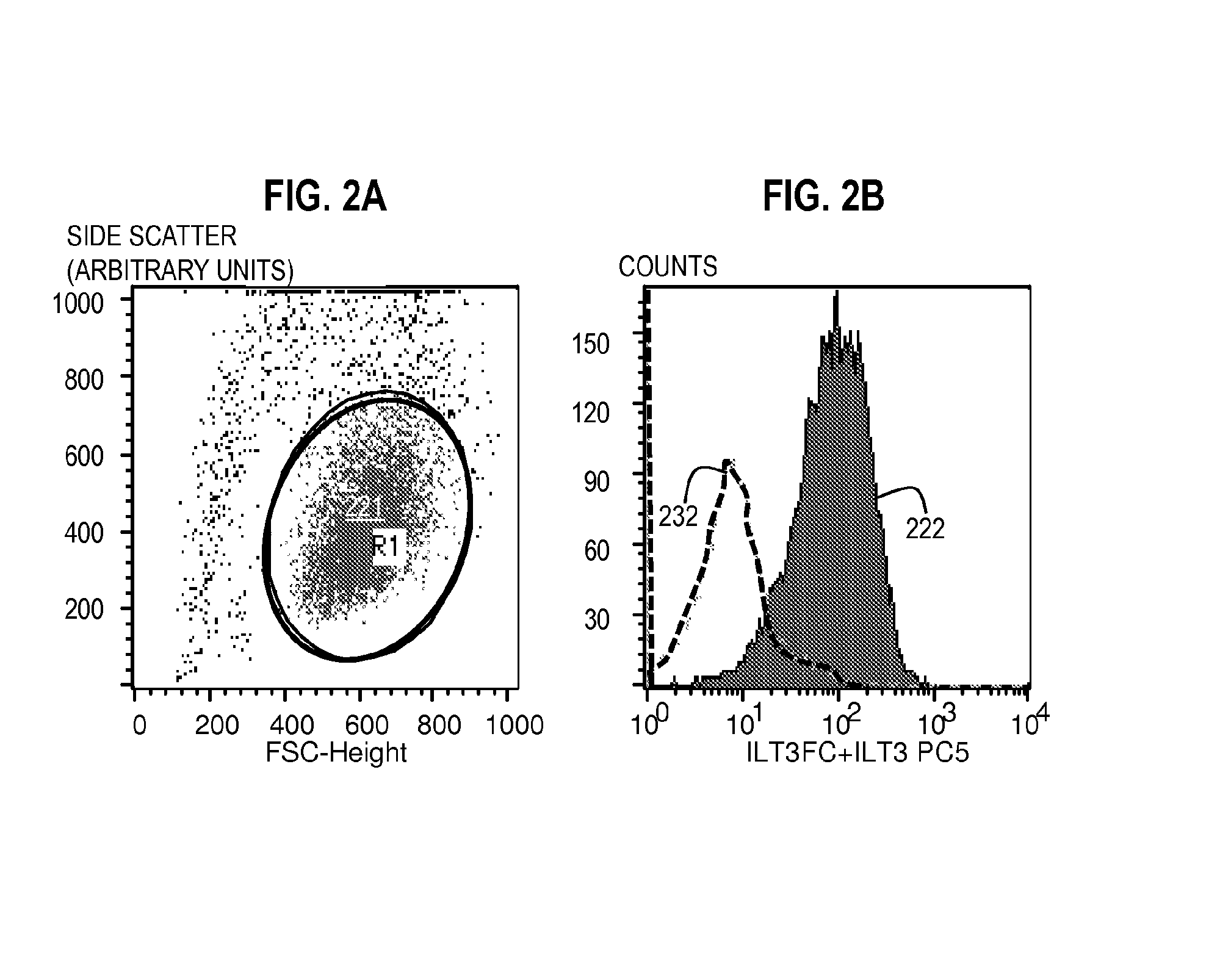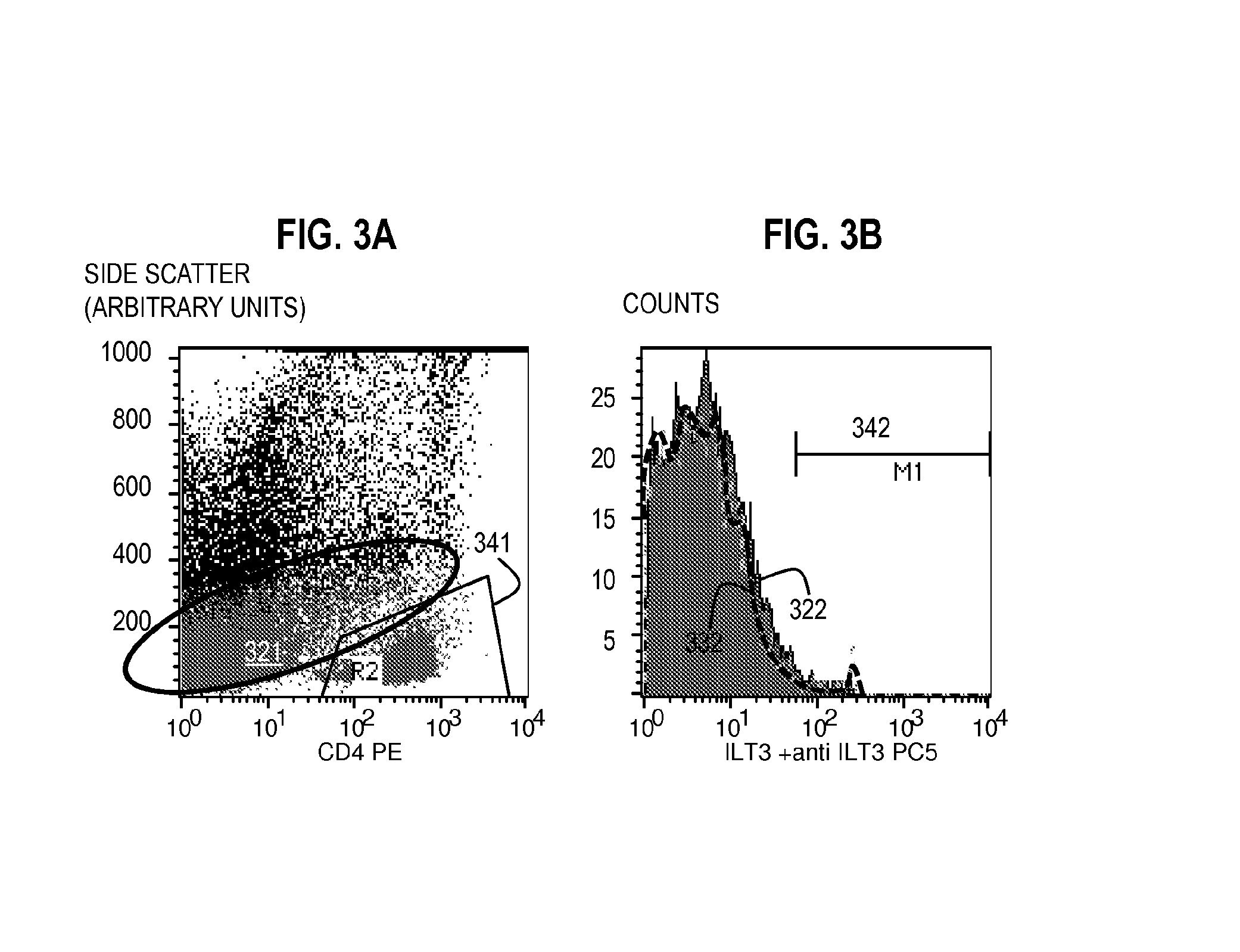Diagnosis and Treatment of Cancer Expressing ILT3 or ILT3 Ligand
a technology of ilt3 or ilt3 and cancer, applied in the direction of assay labels, drug compositions, peptides, etc., can solve the problems of difficult diagnosis and often inaccessible data
- Summary
- Abstract
- Description
- Claims
- Application Information
AI Technical Summary
Benefits of technology
Problems solved by technology
Method used
Image
Examples
example 1
[0100]Flow Cytometry Method for Assaying the Expression of ILT3L Using Unlabeled ILT3Fc and a Labeled Secondary Reagent with Specific Affinity for ILT3Fc.
[0101]Bone marrow aspirate including peripheral blood mononuclear cells from patients with T-ALL or cultured T-ALL cell lines were incubated with 10 μg of unlabeled ILT3Fc for 30 minutes at 4° C. in 100 μl of staining buffer. The staining buffer consisted of Tris buffered saline (TBS), 1-3 mM Mn2, and 1% BSA or a similar formulation. Of note, ILT3Fc is preferably dissolved in a buffer compatible with the staining buffer used. Cells were washed three times in staining buffer. An appropriate negative control consisted of the same type of cells incubated with buffer alone (no ILT3Fc) or 10 μg human IgG during the first step.
[0102]The cells were then incubated with a secondary reagent (such as anti-Human ILT3 antibody) that binds to the ILT3 in the probe, wherein the secondary reagent is conjugated to a fluorophore such as PC5) for (30...
example 2
[0107]Targeted Lysis of T-ALL Cells that Express ILT3L with ILT3 Ligand-Binding Probes
[0108]T-ALL cells were suspended in RPMI 1640 medium at a concentration of 2×106 cells / ml. First, cells were labeled with carbofluorescin diacetate (CFDA, 5 μM) for 10 minutes at 25° C., followed by thorough washing. The cells were then incubated with ILT3Fc (an ILT3 ligand-binding probe) (various concentrations, 0-250 μg / ml) for one hour at room temperature, then washed three times and incubated with rabbit complement for an additional hour.
[0109]Negative controls: the incubations were conducted without ILT3Fc, complement or both. Positive controls consisted of cells incubated with pooled human serum from allosensitized patients (containing anti HLA cytotoxic antibodies) as a first step and rabbit complement as a second step.
[0110]Finally, a viability dye (Ethidium Bromide, EtBr) was added and the cells were analyzed under a 488 nm light source. (Under 488 nm light, live cells appear green [CFDA+E...
example 3
[0113]Methods for making Anti-Human ILT3Fc Monoclonal Antibodies (mAb)
[0114]The procedures for production of monoclonal antibody were adapted from Current Protocols in Immunology (1995) 2.5 contributed by Wayne M. Yokoyama. A person of skill in the art would know how to make mAb from the antigen.
Immunization to Produce Monoclonal Antibodies.
[0115]1. Mix equal volume of human ILT3Fc protein (1 mg / ml in PBS) and CFA (Complete Freunds adjuvant, Sigma) or IFA (Incomplete Freund's adjuvant, Sigma) in a 3-way stopcock until the two parts are completely emulsified. The emulsion with CFA is used for the first time immunization. IFA emulsion is used for the rest of the immunization and boosting.
[0116]2. Inject 0.2 ml of emulsion (100 μg of ILT3Fc protein) intraperitoneally into female BALB / cj mice of 6-7 week old (JAX MICE) on day 1, 8, 15. The immunized mice are rested for 21 days, and are then boosted with 0.2 ml emulsion with IFA. Three days after boosting, mice are sacrificed, and their ...
PUM
| Property | Measurement | Unit |
|---|---|---|
| concentrations | aaaaa | aaaaa |
| fluorescent | aaaaa | aaaaa |
| time course | aaaaa | aaaaa |
Abstract
Description
Claims
Application Information
 Login to View More
Login to View More - R&D
- Intellectual Property
- Life Sciences
- Materials
- Tech Scout
- Unparalleled Data Quality
- Higher Quality Content
- 60% Fewer Hallucinations
Browse by: Latest US Patents, China's latest patents, Technical Efficacy Thesaurus, Application Domain, Technology Topic, Popular Technical Reports.
© 2025 PatSnap. All rights reserved.Legal|Privacy policy|Modern Slavery Act Transparency Statement|Sitemap|About US| Contact US: help@patsnap.com



